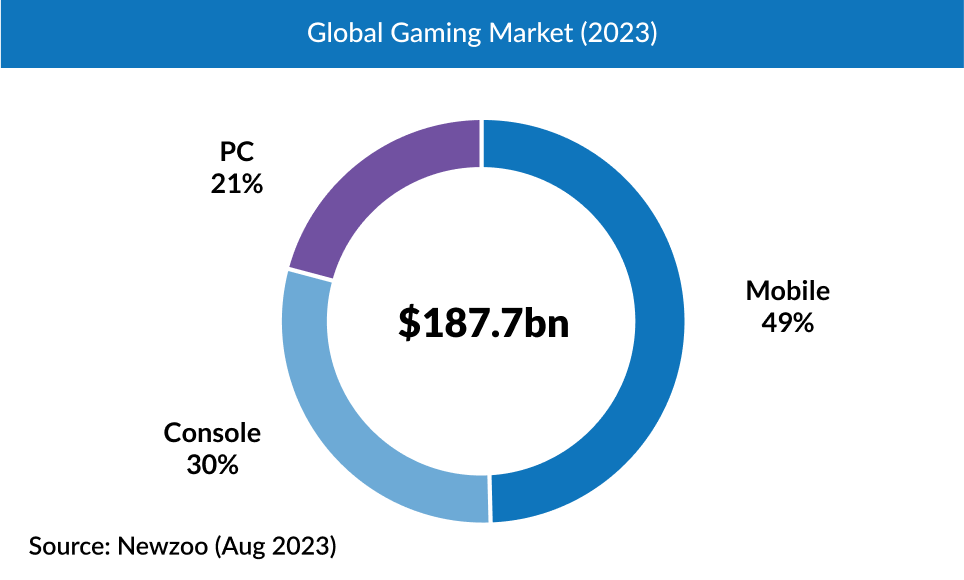Imagine a world where every sword swing, every piece of virtual land, and every in-game achievement isn’t just a mark of your dedication, but a tangible asset you own and can trade at will. Welcome to the evolving landscape of gaming, where the lines between play, investment, and real- world value blur, thanks to the advent of blockchain technology. But as we stand on the brink of this new frontier, it’s worth asking: Are we witnessing the dawn of a gaming revolution, or are we merely adding a layer of complexity to the digital worlds we seek to escape into? Let’s dive into the heart of blockchain gaming to unravel its innovations, its challenges, and its promise to reshape how we play, earn, and interact within these virtual worlds.
The Gaming Market Today
Gaming is not just big business; it’s a colossal industry. Despite a recent slowdown, the global gaming market boasted estimated sales of approximately $188Bn in 2023, according to Newzoo. With median EBITDA margins around 38% for the largest publicly traded gaming companies, successful gaming companies are highly cash generative. It is clear why investors keep a keen eye on this sector. The business model in gaming has evolved considerably over the past decade.
Today, 60% of monetization across mobile, PC, and console gaming occurs via in-game purchases according to Newzoo. For most games, in-game purchases occur through a centralized marketplace. Some games, such as Valve’s CS:GO, Dota 2, or Team Fortress 2, allow their communities to create custom items or skins that can be sold via direct trading systems. In traditional gaming, all aspects of the in-game economy, including the approval and transacting of in-game items, are maintained on the centralized servers of the game publisher, which creates a number of problems. If a game allows members of a game’s community of players to create in-game items, those community members face platform risk from selling through the game’s marketplace. Moreover, the marketplaces of Valve’s are facilitated by Valve’s Steam distribution platform. If a third-party publisher wanted to use similar marketplace mechanics, they would need to rely upon Steam or similar distribution platform as an intermediary (also a source of platform risk) or go through the complexity of building their own secure marketplace.
Blockchain Gaming’s Benefits And Fit Within Current Gaming Trends
Blockchain gaming introduces a paradigm shift, integrating blockchain technology to unlock features like digital asset ownership, unmatched transparency, and seamless interoperability—elements traditional gaming infrastructures can’t offer. These features have the potential to create more open and vibrant gaming economies, limit take-rates on transactions, and reduce platform risk for experiences built on existing games. Blockchain gaming has already given rise to new business models and will likely continue to innovate on how game’s create, capture, and share value.
A number of the innovations already introduced by blockchain gaming have the potential to significantly enhance one or more current trends in the broader gaming industry. For example, the ownership and the potential for vibrant player economies could play a role in the live-service gaming model where an individual game is designed to be played over a long period of time with the regular addition of new purchasable content. Well before the advent of blockchain gaming, a growing share revenue was generated from free-to-play games where player monetization occurred through the purchase of in-game assets. The ownership and free trade of digital assets has the potential to create a larger and more dynamic player economy where the gaming community contributes to both the demand side and the supply side of free-to-play games. Finally, social monetization such as that enabled via friend.tech’s innovative model is highly relevant to the growing importance of eSports and streamers.

Furthermore, the open-source nature of blockchain technology allows independent developers to leverage established blockchain ecosystems such as Ethereum or Solana. This accessibility can spark a surge of creativity, empowering ambitious developers to craft games beyond the confines of major studios for the first time. By working on these open networks, developer scan tap into the network effects and established distribution channels of these blockchains, potentially revolutionizing how games are created and distributed.
Historically, the PC gaming industry has seen the power of community-driven development since the early 1990s embracing of open-source models. Iconic titles such as Counter-Strike and League of Legends, for example, began as mods created by the community, demonstrating the potential of collaborative development. Blockchain gaming extends this tradition, offering the modding community new ways to monetize their creations. In our next blog post, we’ll explore the various pathways through which blockchain gaming can enable developers to generate revenue from their work, marking a significant shift in how games are developed and monetized.
Challenges Facing Blockchain Gaming
Blockchain gaming is not without its criticisms. A common criticism is that, to date, blockchain game’s major innovation has been the play-to-earn (P2E) business model popularized by Axie Infinity, which enables players to earn real-world value through in-game activities. This model has struggled with user retention and sustainable economics as it relies upon a constant influx of new players and funders to support its economy with later entrants being unable to earn meaningful rewards. Moreover, the focus on financial incentives sometimes overshadowed the essence of gaming—engagement and fun. This misalignment risks diminishing player retention and the intrinsic value of tradable in-game assets. Current developers have recognized the shortcomings of the first iteration of blockchain games and have since pivoted to more sustainable gaming models, such as free-to-play experiences, similar to those seen in mobile gaming.
Another headwind for blockchain games is that the unique “pain points” they address are desirable but not critical features for gamers and developers under current gameplay designs. As such, they do not benefit from a significant pull factor today. For example, the ability to truly own an in-game item or to freely trade an in-game item via an open platform built on blockchain rails benefits players and third-party content creators, but such features would have to first be incorporated in a compelling gaming experience that is competitive with today’s leading offerings before it is widely adopted.
A beneficial feature of blockchain games is interoperability. The open, permissionless infrastructure on which these games are built could theoretically facilitate the transfer of digital assets from one game into another. This could be a novel way to bootstrap a new game’s audience from an existing game or facilitate cross-platform play for games released on multiple platforms, but there exist significant technical and design hurdles in cross-game integration. In-game assets are usually carefully balanced against all other items. Therefore, introducing new assets from another game whose attributes have not been balanced would disrupt the basic design of the game.
A critical challenge for blockchain gaming lies in penetrating mobile gaming, the industry’s largest and fastest growing segment. Mobile app stores are effective monopolies on their native devices, meaning the inclusion of a blockchain game on these app stores is at the sole discretion of Apple or Google. In Apple’s iOS app store, financial transactions must occur through its in-app purchase system, which enables Apple to collect a fee. This policy complicates the integration of blockchain-based assets used within a game, as transactions involving the assets typically bypass traditional in-app purchase systems.
Harnessing Blockchain’s Potential in Gaming
To navigate the future of blockchain gaming, developers must innovate beyond the allure of digital asset monetization, focusing on creating engaging, immersive gaming experiences that can coexist with traditional models. For investors, the opportunity lies in identifying projects that not only understand the intricacies of blockchain technology but also prioritize compelling gameplay and sustainable economic models. As the industry evolves, the games that successfully blend these elements will not only captivate players but also set new standards for gaming. The journey of blockchain gaming is just beginning, and its true potential remains to be unlocked. By addressing its current challenges head-on, this new frontier has the power to redefine the gaming landscape, offering unprecedented opportunities for players, developers, and investors alike. In our next blog post, we will take a deeper look at the investable token landscape underpinning blockchain gaming and the future potential for blockchain games.
Disclaimer: Unless otherwise indicated, the views expressed in this post are solely those of the author(s) in their individual capacity and are not the views of ProtoCap Management LLC or its affiliates (together with its affiliates, “ProtoCap”). Certain information contained herein may have been obtained from third-party sources, including from portfolio companies of funds managed by ProtoCap. ProtoCap believes that the information provided is reliable but has not independently verified the non-material information and makes no representations about the enduring accuracy of the information or its appropriateness for a given situation. This post may contain links to third-party websites (“External Websites”). The existence of any such link does not constitute an endorsement of such websites, the content of the websites, or the operators of the websites. These links are provided solely as a convenience to you and not as an endorsement by us of the content on such External Websites. The content of such External Websites is developed and provided by others and ProtoCap takes no responsibility for any content therein. Charts and graphs provided within are for informational purposes solely and should not be relied upon when making any investment decision. Any projections, estimates, forecasts, targets, prospects, and/or opinions expressed in this blog are subject to change without notice and may differ or be contrary to opinions expressed by others.
The content is provided for informational purposes only, and should not be relied upon as the basis for an investment decision, and is not, and should not be assumed to be, complete. The contents herein are not to be construed as legal, business, or tax advice. You should consult your own advisors for those matters. References to any securities or digital assets are for illustrative purposes only, and do not constitute an investment recommendation or offer to provide investment advisory services. Any investments or portfolio companies mentioned, referred to, or described are not representative of all investments in vehicles managed by ProtoCap, and there can be no assurance that the investments will be profitable or that other investments made in the future will have similar characteristics or results. This blog does not constitute investment advice or an offer to sell or a solicitation of an offer to purchase any limited partner interests in any investment vehicle managed by ProtoCap. An offer or solicitation of an investment in any ProtoCap investment vehicle will only be made pursuant to an offering memorandum, limited partnership agreement and subscription documents, and only the information in such documents should be relied upon when making a decision to invest.
Past performance does not guarantee future results. There can be no guarantee that any ProtoCap investment vehicle’s investment objectives will be achieved, and the investment results may vary substantially from year to year or even from month to month. As a result, an investor could lose all or a substantial amount of its investment. Investments or products referenced in this blog may not be suitable for you or any other party.


